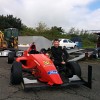autogyro wrote:hardingfv32 wrote:Could using a pulsating KERS charging schedule during acceleration improve traction when the tires are at the limit? It allows them to re-grip after they start sliding. I am thinking about the MotoGP 'Big Bang' operating mode where the power output is not evenly distributed during a single rpm. The tires are given an opportunity to re-grip each power cycle.
This might make it easier to drive closer on the traction limit.
Brian
Very good comparison, I am well aware of the 'big bang' theory of traction control.
Consulted with Honda for a while.
Of course the Norton Rotary did not suffer from the problem so the Japanese banned it.
A pity because the Norton Rotary would still be much faster than the current Japanese racing bikes.
a (premeditated) pusating KERS charging schedule I would call a torque ripple action
I have also tried to highlight the inherent KERS/ERS characteristic of wheelspin-specific EM torque variation
(this could be seen as another kind of pulsating charging)
such torque ripple must be related to the mechanical characteristics of the whole transmission train from motor to the track
the ripple frequency must be suitably low so being matched to and working with these characteristics
surely this is what was proven by footage of tyre chatter marks as they were generated in Canada ?
torque ripple can of course be achieved mechanically (and is in F1 ?), although they try to eliminate it from our road vehicles
though 'Big Bang' is to me still unevidenced and a myth
(the Blair paper that Brian kindly sent me is about power curve effects of various induction intervals, Blair distances himself from 'BB')
the supposed 'BB' torque variation is at far too high a frequency (at eg 12000 rpm) to propagate via the tyre/s to the track
the torsional or surge frequency of the vehicle/tyre system is maybe 5-15 Hz (people with strong friends can try this at home)
the tyre acts as a low pass filter (straddling a low frequency resonant peak)
behaving like our car engines on their mountings, this has an isolation effect at the 'BB' frequencies
btw
the 'BB' story appeared as an explanation of the success of the Doohan/Honda combination
but the losers were also 'BB' (more or less), but that was conveniently ignored
(4 cyl 2 stroke GP machines had for decades been pair-firing square 4s or pseudo V4s, to reduce ignition complexity and bulk)
so the Doohan era Hondas were only slightly more uneven, options anyway driven by their package of increased V angle
'BB' stories have reappeared regarding the recent MotoGP Yamahas (the only non V engines, they have crossplane cranks)
crossplane cranks give evenly-spaced inertial forces, at the expense of unevenly-spaced firing forces (opposite to all our experience)
at any reasonably high rpm (even those in our road vehicles) the inertia forces (ie reciprocation) are much bigger than firing forces
(and twice as frequent)
the crossplane crank will be slimmer with much less bearing friction (lower rubbing speeds)
handy in a fuel-limited race
this or other cranks that give uneven firing intervals could have fewer main bearings
(Johnny Giles made a simultaneous-firing version of his (Triumph) employers scrambles/motocross twin, they threatened to fire him)
the Yankee (Ossa ?) off-road twin was also made simultaneous-firing
thousands of 'English trials' were won (maybe on torque ripple) with single-cylinder motors run at 300-400 rpm, by hand control of spark timing
has anyone ever seen a paper supporting 'BB' ?



